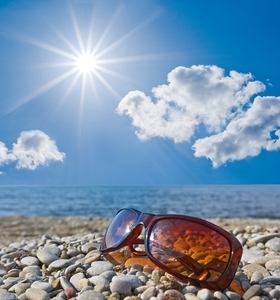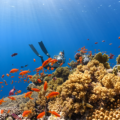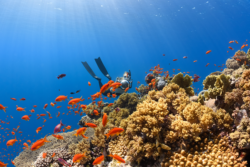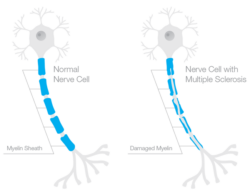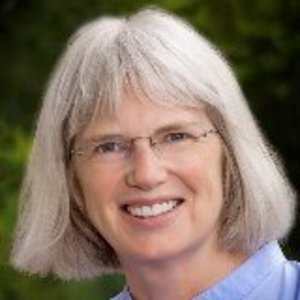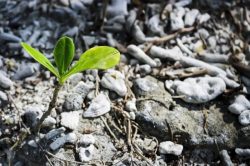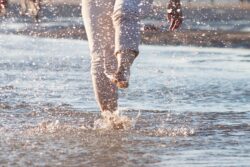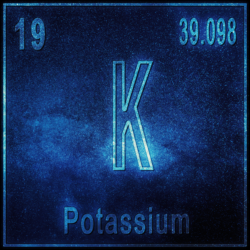I worship the sun. Perhaps it has to do with my astrological sign (Leo), or the fact I was born on a hot humid day in August, or, since I also love the humidity, perhaps it’s a carryover from having been a Southern Belle in a previous life? Whatever the reason I’m happy when the sun is out and I’m generally out when it’s out. Nevertheless, I’ve had to learn the hard way to change my relationship with the sun.
Lesson I: Sun Poisoning & Suntanning
My earliest memory of the sun’s potent effects was a on a trip to Acapulco when I was seven. I got so sunburned the first day of the vacation that I spent the remaining six days in bed, violently ill and in pain with sun poisoning. I could have been the Coppertone poster child except I was too sick to stand up.
The summer I was fifteen, my best friend and I went to the beach near our homes in Southern California every single day. We slathered ourselves with Johnson’s baby oil and tried to look busy reading our Kathleen E. Woodiwiss novels while lying on our beach towels, all the while hoping some handsome young studs would notice what bronzed goddesses we were.
The following two summers I was a life guard at our community pool. I burned my nose so many times the first summer that it became bulbous and my supervisor finally purchased a tube of zinc oxide cream for me and insisted I apply it religiously. This was before the days of SPF lotions, and was my introduction to protecting myself from the harmful effects of UV rays.
However, I still wasn’t fully on board with the idea of sun protection. It didn’t help that when I arrived to college on the east coast in late summer 1980, I was on just about every boy’s radar because of my deep tan and sun-bleached hair.
Lesson II: Basal Cell Carcinoma
The risk I was putting myself at didn’t truly begin to sink in until 1989 when my brother had a biopsy of a small polyp on the bridge of his nose and learned he had malignant basal cell carcinoma. Basal cell is a non-melanoma skin cancer that arises from small round cells found in the lower part of the epidermis. In order to remove all the malignant cells, his surgeon had to carve up his face like a Thanksgiving turkey leaving him permanently scarred and disfigured. Fortunately, the margins came back clear and he’s lived cancer-free ever since.
Shortly after the incident with my brother, I had my first child. I became a religious applier of sunscreen to my baby’s skin, if not always my own. As the years passed and I began to notice crow’s feet and sun spots taking their rightful places on my skin, I took more precautions. For me, it took vanity, not my brother’s skin cancer, to become a full-on sunscreen aficionado.
Lesson III: Dysplastic Nevi (Atypical Melanoma)
In 2007, my son, who’d been the primary benefactor of my brother’s misfortune, and who had always, like me, had a lot of moles, had one removed from the base of his thumb. The biopsy report indicated dysplastic nevi, a benign mole that resembles and may predict single or multiple melanomas. The higher the number of these moles someone has, the higher the risk of cancer. Those who have dysplastic nevi, plus a family history of melanoma (two or more close blood relatives with the disease) have an extremely high risk of developing melanoma. Individuals who have dysplastic nevi, but no family history of melanoma, still face a 7 to 27 times higher risk of developing melanoma compared to the general population.
My son returned to the dermatologist who dug out a large chunk of skin from my son’s hand. Yet, this brush with melanoma occurred during an inconvenient time. My son had recently been diagnosed with a brain malformation and was awaiting surgery. An atypical melanoma seemed the least of our worries.
Lesson IV: Acral Lentiginous Melanoma
Fast forward three years to 2010. My 81-year old father, also a sun worshiper, took my stepmother to a dermatology appointment. At the end of the appointment, as he helped my step mom slip into her sweater, the dermatologist stopped him and said, “let me see your thumb there.” My dad told the doctor that the black vertical streak on the inside of the thumbnail had been there for a few years. Concerned, the doctor scheduled a biopsy. Sure enough, it came back positive for acral lentiginous melanoma.
Lentigenous-type melanoma is the most commonly diagnosed melenoma in Asian and black populations, however, it is extremely rare among Caucasians. Bob Marley had acral lentiginous melanoma. Similar to my dad, Marley’s melanoma presented itself as a macule, or spot, on his big toenail. These spots can look like the type of black and blue spot you might get if you caught your fingers in a door, and frequently they are neglected. Bob Marley’s melanoma eventually metasticized and into the brain tumor that eventually took his life.
My dad was more, or less fortunate. He submitted to exploratory surgery, and since his melanoma was detected relatively early, the surgeon only needed to amputate half his thumb.
Lesson Learned
There’s an adage that a lesson will be repeated to you in various forms and at various turns until you learn it. Then you can go onto the next lesson. Even though acral lentiginous melanoma does not appear to be linked to sun exposure, rarely occurs in Caucasians, and the average age at diagnosis is between sixty and seventy years, and I was adopted so I have no reason to think I have a genetic predisposition, I finally learned my lesson. After these several wake up calls, I now understand that the risk at which my genes and my mistakes have placed me warrant monthly self-examination, regular professional skin exams and daily sun protection. No exceptions.
If you, like me, are thick skinned due to sun exposure and thick sculled due to a stubborn nature, and have yet to learn your lesson, then you may want to consider a few salient facts:
- One-in-50 Americans has a lifetime risk of developing melanoma.
- In 2009 nearly 63,000 were diagnosed with melanoma in the United States, resulting in approximately 8,650 deaths.
- The projected numbers (according to the National Cancer Institute) for 2012 are even higher with 76,250 diagnosis and 9,180 deaths.
Here are some prevention tips that I follow:
- Seek the shade, especially between 10 AM and 4 PM.
- Do not burn.
- Avoid tanning and UV tanning booths.
- Cover up with clothing, including a broad-brimmed hat and UV-blocking sunglasses.
- Use a broad spectrum (UVA/UVB) sunscreen with an SPF of 15 or higher every day.
- For extended outdoor activity, use a water-resistant, broad spectrum (UVA/UVB) sunscreen with an SPF of 30 or higher.
- Apply 1 ounce (2 tablespoons) of sunscreen to your entire body 30 minutes before going outside.
- Reapply every two hours or immediately after swimming or excessive sweating.
- Keep newborns out of the sun. Sunscreens should be used on babies over the age of six months.
- Examine your skin head-to-toe every month.
- See your physician every year for a professional skin exam.
Lucine Medical Disclaimer: All material on this website is provided for your information only and may not be construed as, nor should it be a substitute for, professional medical advice. To read more about our health policy, see Terms of Use.
